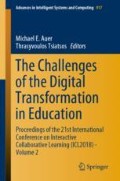Abstract
Teaching about fractions is a challenging topic for teachers since it includes complex conceptual content. The number line is a visual representation tool that seems to be effective for dealing with fractions. In this study, we aim at transforming the static uncontextualized paper-and-pencil number line into a practical, useful and dynamic measurement tool in an authentic gamified context. We present the mixed reality environment “Marathon of Fractions” which enables learners to position multiple number lines in any place of the augmented space and adjust their characteristics as they wish. The number lines are used for positioning athletes and other props on an augmented stadium. To evaluate our proposal, 28 6th grade students participated in groups of two in 14 sessions which lasted for about 45 min. At the end of each session, students were asked to complete a questionnaire about their experience while sixteen students also participated in brief interviews. Students assessed the environment as effective, enjoyable, innovative, helpful and expressive and claimed that it stole their attention for 45 min even though fraction learning is an unpopular subject matter. They also pinpointed as main advantages of the proposed environment the representational power of the interactive number lines, the authenticity of the environment, the feedback mechanism, the entertaining character of the activity and the collaboration required.
Access this chapter
Tax calculation will be finalised at checkout
Purchases are for personal use only
References
Jordan, N.C., Hansen, N., Fuchs, L.S., Siegler, R.S., Gersten, R., Micklos, D.: Developmental predictors of fraction concepts and procedures. J. Exp. Child Psychol. 116, 45–58 (2013)
Siegler, R.S., Duncan, G.I., Davis-Kean, P.E., Duckworth, K., Claessens, A., Engel, M., Chen, M.: Early predictors of high school mathematics achievement. Psychol. Sci. 23, 691–697 (2012)
Riconscente, M.: Mobile learning game improves 5th graders’ fractions knowledge and attitudes. GameDesk Institute, Los Angeles (2011)
Fazio, L., Siegler, R.S.: Teaching Fractions. International Academy of Education (2011)
Saxe, G.B., Diakow, R., Gearhart, M.: Towards curricular coherence in integers and fractions: a study of the efficacy of a lesson sequence that uses the number line as the principal representational context. ZDM 45(3), 343–364 (2012)
Lindgren, R., Tscholl, M., Wang, S., Johnson, E.: Enhancing learning and engagement through embodied interaction within a mixed reality simulation. Comput. Educ. 95, 174–187 (2016)
Malinverni, L., Pares, N.: Learning of abstract concepts through full-body interaction: a systematic review. J. Educ. Technol. Soc. 17(4), 100 (2014)
Siegler, R.S., Thompson, C.A., Schneider, M.: An integrated theory of whole number and fractions development. Cogn. Psychol. 62(4), 273–296 (2011)
Wu, H.: Teaching fractions according to the Common core standards. Retrieved 24 Feb 2014 (2011)
Hannula, M.S.: Locating fraction on a number line. Int. Group Psychol. Math. Educ. 3, 17–24 (2003)
Lemonidis, C.: Mental Computation and Estimation: Implications for Mathematics Education Research, Teaching and Learning. Routledge (2015)
Domahs, F., Moeller, K., Huber, S., Willmes, K., Nuerk, H.C.: Embodied numerosity: implicit hand-based representations influence symbolic number processing across cultures. Cognition 116(2), 251–266 (2010)
Carbonneau, K.J., Marley, S.C., Selig, J.P.: A meta-analysis of the efficacy of teaching mathematics with concrete manipulatives. J. Educ. Psychol. 105(2), 380 (2013)
Cramer, E.S., Antle, A.N.: Button matrix: how tangible interfaces can structure physical experiences for learning. In: Proceedings of the Ninth International Conference on Tangible, Embedded, and Embodied Interaction (pp. 301–304). ACM (Jan 2015)
Martin, T., Schwartz, D.L.: Physically distributed learning: Adapting and reinterpreting physical environments in the development of fraction concepts. Cogn. Sci. 29(4), 587–625 (2005)
Antle, A.N.: The CTI framework: informing the design of tangible systems for children. In: Proceedings of the 1st International Conference on Tangible and Embedded Interaction, pp. 195–202. ACM (Feb 2007)
Alibali, M.W., Nathan, M.J.: Embodiment in mathematics teaching and learning: evidence from learners’ and teachers’ gestures. J. Learn. Sci. 21(2), 247–286 (2012)
Edwards, L.D., MooreRusso, D., Ferrara, F. (Eds.): Emerging Perspectives on Gesture and Embodiment in Mathematics. IAP (2014)
Abrahamson, D., Black, J. B., DeLiema, D., Enyedy, N., Hoyer, D., Fadjo, C.L., Trninic, D.: You’re it! Body, action, and object in STEM learning. In: Proceedings of the International Conference of the Learning Sciences: Future of Learning (ICLS 2012), vol. 1, pp. 283–290 (2012)
Fischer, U., Moeller, K., Bientzle, M., Cress, U., Nuerk, H.C.: Sensori-motor spatial training of number magnitude representation. Psychon. Bull. Rev. 18(1), 177–183 (2011)
Mavilidi, M.F., Okely, A., Chandler, P., Domazet, S.L., Paas, F.: Immediate and delayed effects of integrating physical activity into preschool children’s learning of numeracy skills. J. Exp. Child Psychol. 166, 502–519 (2018)
Fischer, U., Moeller, K., Huber, S., Cress, U., Nuerk, H.C.: Full-body movement in numerical trainings: a pilot study with an interactive whiteboard. Int. J. Serious Games 2(4), 23–35 (2015)
Mpiladeri, M., Palaigeorgiou, G., Lemonidis, C.: Fractangi: A Tangible Learning Environment for Learning about Fractions with an Interactive Number Line. International Association for Development of the Information Society (2016)
Hassenzahl, M., Monk, A.: The inference of perceived usability from beauty. Hum.-Comput. Interact. 25, 235–260 (2010)
Jackson, S.A., Marsh, H.W.: Development and validation of a scale to measure optimal experience: the flow state scale. J. Sport Exerc. Psychol. 18, 17–35 (1996)
Author information
Authors and Affiliations
Corresponding author
Editor information
Editors and Affiliations
Rights and permissions
Copyright information
© 2019 Springer Nature Switzerland AG
About this paper
Cite this paper
Palaigeorgiou, G., Tsolopani, X., Liakou, S., Lemonidis, C. (2019). Movable, Resizable and Dynamic Number Lines for Fraction Learning in a Mixed Reality Environment. In: Auer, M., Tsiatsos, T. (eds) The Challenges of the Digital Transformation in Education. ICL 2018. Advances in Intelligent Systems and Computing, vol 917. Springer, Cham. https://doi.org/10.1007/978-3-030-11935-5_12
Download citation
DOI: https://doi.org/10.1007/978-3-030-11935-5_12
Published:
Publisher Name: Springer, Cham
Print ISBN: 978-3-030-11934-8
Online ISBN: 978-3-030-11935-5
eBook Packages: Intelligent Technologies and RoboticsIntelligent Technologies and Robotics (R0)

